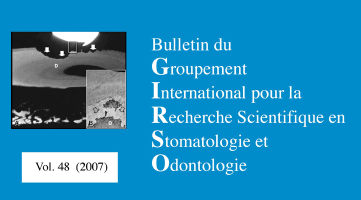Enrichment Cultures should be performed in the detection of Bacterial Oral Human Pathogens in DUWLs
Abstract
Water delivered by dental units during routine dental practice is densely contaminated by bacteria. The aim of this study was to determine actual isolation of the microorganisms sprayed from Dental Unit Water Lines (DUWLs) when enrichment cultures are performed and to compare frequencies with those obtained without enrichment cultures. Moreover, the antimicrobial susceptibilities of the microorganisms isolated were also studied. Water samples were collected from one hundred dental equipments in use at Dental Hospital of our University in order to evaluate the presence/absence of microorganisms and to perform their presumptive identification. Aliquots from all of the samples were inoculated in eight different media including both enrichment and selective media. Minimal inhibitory concentrations (MIC) were determined by the broth dilution method. The results herein reported demonstrate that most of the DUWLs were colonized by bacteria from human oral cavity; when enrichment procedures were applied the percentage of DUWLs with detectable human bacteria was one hundred percent. The results showed that in order to evaluate the actual risk of infections spread by DUWLs the inclusion of a step of pre-enrichment should be performed. The need for devices preventing bacterial contamination of DUWLs is a goal to be achieved in the near future that would contribute to maintain safety in dental medical assistance.Downloads
Published
Issue
Section
License
I hereby certify that the authors of the above manuscript have all:
1. Conceived, planned, and performed the work leading to the report, or interpreted the evidence presented, or both;
2. Written the report or reviewed successive versions and shared in their revisions; and
3. Approved the final version.
Further, I certify that:
1. This work has not been published elsewhere and is not under revision in another journal;
2. Humane procedures have been followed in the treatment of experimental animals (if applicable);
3. Investigations in humans was done in accordance with the ethical standards of the responsible committee on human experimentation or with the Helsinki Declaration (if applicable).
4. This paper has been carefully read by a native English speaker who is familiar with the field of work (this applies to authors who are not fluent in English); and
5. The copyright of the article is transferred from the authors to the Bulletin du Groupement International pour la Recherche Scientifique en Stomatologie et Odontologie upon acceptance of the manuscript.



